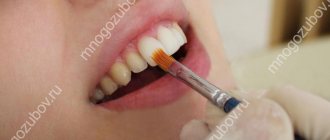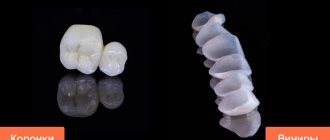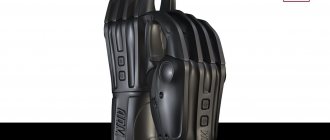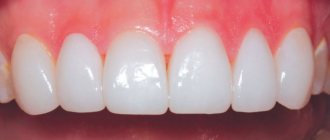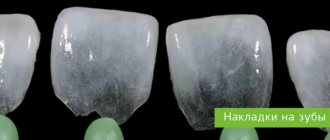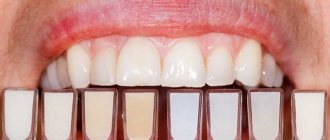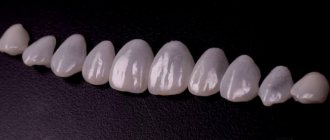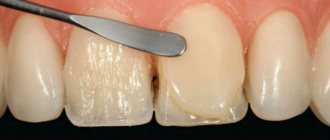E.max Press ceramics can be used to represent various dental objects: veneers, crowns, onlays and inlays. What material the inlays are made from is decided by the dentist himself.
Application area
The scope of application of E.max Press ceramic inlays is extensive. The ceramic inlay is used from conventional prosthetics to the installation of onlays on teeth for their impeccable beauty (Lumineers).
The inlay contains zirconium oxide, which is used to create more durable structures, for example, to restore the anatomical integrity of teeth, and lithium disilicate is used for lighter structures (for example, to restore anterior teeth). It also contains glass ceramics and leucite crystals, which increases the overall strength of the structure.
The E.max ceramic inlay has been used for a long time for the manufacture of this type of structure:
- Veneers and lumineers. Previously, veneers were made from photopolymers, but their short service life forced modern dentists to abandon them. Metal-free veneers are more beautiful and durable.
- Crowns: a classic dental element that has found a new life with E.max. For front teeth, this is the best solution compared to metal-ceramics.
- Inlays: an alternative to photopolymers, which tend to wear out over time. Made under special conditions, ceramic inlays are more durable and less susceptible to abrasion. An exception for E.max is the impossibility of installing long bridges.
An aesthetic smile has always attracted people. Modern dentistry uses every opportunity and means to improve the external characteristics of the dentition.
The appearance of the E.max Press ceramic inlay on the market about 20 years ago exploded the dental market, because it was truly a major breakthrough. Previously, metal-ceramic inserts were used, which were harmful to the patient’s oral cavity.
Types of E-max ceramics –
There are 2 main options for E-max ceramics for the manufacture of veneers and crowns - these are “IPS E-max RPESS” and “IPS E-max CAD”. The indications for their use are very different, as are the technologies for making restorations from these materials, and therefore we will talk about each of them separately.
1) IPS “E-max RPESS” (pressed ceramics) –
E-max RPESS is a glass ceramic designed for injection molding under high temperature and pressure conditions. Pressed ceramics E-max has a very high strength - 400 MPa, which is several times greater than the strength not only of pressed ceramics made from any other materials, but also the strength of E-max CAD.
The excellent aesthetics of the material, together with high strength, make it possible to make from E-max RPESS not only single crowns, but also bridges of up to 3 units inclusive, and even ultra-thin veneers and lumineers. E.max RPESS significantly exceeds the aesthetic capabilities of another type of metal-free ceramic - zirconium dioxide, both due to the greater transparency of the material and due to a greater number of color shade options (Fig. 4-9).
Clinical case No. 1 – before and after photos
Clinical case No. 2 – before and after photos
In addition to the classic material “E-max RPESS”, there is also an improved version called “E-max RPESS Multi”. The second material differs from the first in that it is polychrome (that is, it has a gradient of color and transparency). Why is this, and why is it important... The fact is that in real teeth, the cutting edge and lateral surfaces of the teeth are whiter and more transparent, and in the area of the neck and center of the crown, the tooth is as opaque as possible and usually has a yellowish tint.
The regular E-max RPESS material has one tone and translucency, which is why only “layered” veneers and E-max crowns are made from it. “Layered” means that only the crown frame (cap) is made by pressing, on top of which layers of porcelain mass and dyes are then applied, which give the veneer or crown its final appearance. Using different shades of porcelain mass on the surface of the pressed cap it is possible to create a gradient of color and transparency (24stoma.ru).
Important: E-max RPESS Multi already has a gradient of color and transparency, and therefore it can be used to make monolithic crowns and veneers, which will consist entirely of pressed material (without layers of porcelain mass on the surface). And the final addition of color and shine will be carried out using dyes and the glazing process. As a result, monolithic veneers and crowns made of E-max pressed ceramics will be much more reliable and practically not susceptible to ceramic chips.
E max crowns: patient videos before and after
2) IPS “E-max CAD” (3D milling method) –
E-max CAD are lithium disilicate blocks designed for milling on a computer-controlled machine using CAD/CAM technology. This is a modern method of making crowns and veneers, with virtually no human intervention. The strength of E-max CAD is about 360 MPa, which is slightly less than that of E-max RPESS pressed ceramic. That is why it is recommended to make only single crowns and veneers of standard thickness from this material.
Another disadvantage of E-max CAD is that there are fewer possibilities for selecting shades, which sometimes may not allow achieving an ideal match in color and transparency of crowns with neighboring teeth. By the way, it is CAD/CAM technology that produces crowns and veneers from zirconium dioxide. How the process of milling crowns from E-max CAD occurs – see the video below.
Clinical case No. 3 – before and after photos
Clinical case No. 4 – before and after photos
So which is better - E-max RPESS or E-max CAD?
E-max RPESS material is the best material both in terms of strength characteristics and the ability to achieve ideal aesthetics. In addition, the production of crowns and veneers from E-max RPESS does not require expensive equipment (unlike E-max CAD), which at the same time means a more acceptable cost for patients.
Moreover, the best option would be to use not the usual plain material “E-max RPESS”, but the pre-colored “E-max RPESS Multi”. The blocks of the latter have a gradient of color and transparency, which will allow, without additional staining and application of layers of porcelain mass, to obtain the same gradient of color and transparency from the center of the crown to its cutting edge. In this case, crowns and veneers can be made as monolithic pressed ceramics, i.e. without additional application of porcelain mass to the surface of the pressed crown frame. This will protect you from chipping the ceramics.
Making crowns from E-max CAD: video
Advantages
Experts emphasize the following advantages of the design:
- Extensive experience in using ceramic liners all over the world. More than 30 million restorations have been registered.
- High structural strength. This is due to the fact that when creating liners, a pressing method is used, which guarantees the hardness and uniformity of the material.
- Aesthetics. Crowns and lumineers allow dentists to fine-tune transparency, color, and highlights to achieve maximum naturalness.
- A light weight. The patient quickly gets used to the feeling of something new on the teeth.
- Anti-allergic composition. Allergy sufferers are very lucky. E.max Press has excellent biocompatibility with the human body, so patients do not have to worry about possible allergic reactions.
- Reliability. This design lasts for many years.
E-max crowns: price 2021
How much does a ceramic crown cost per tooth in mid-price clinics? First of all, this will depend on which version of the E.max material the veneer or crown will be made from and, accordingly, what technology will be used (this can be either a pressing technique or CAD/CAM technology).
Ceramic crown for a tooth: price for 1 unit
- A crown made from Emax PRESS material will cost you an average of 21,000 rubles, and a veneer made from this material will cost you approximately 25,000 rubles. Moreover, most often when ordering 4 or 6 veneers at once, clinics give a discount of approximately 15-20%.
- A crown made of Emax CAD material will cost at least 30,000 rubles. 20,000 rubles.
Moreover, it should be taken into account that this cost usually does not include temporary crowns made of plastic (the cost of 1 temporary crown is additionally about 1500-2000 rubles). By the way, in the regions of Russia the price of the Emax PRESS ceramic crown will be slightly lower, for example, it can be about 18,000 rubles.
Indications for use
E.max Press shown:
- for creating ceramic crowns;
- for restoration of tooth enamel and teeth;
- for installation of implants;
- to eliminate dental defects (gaps between teeth);
The design also has contraindications:
- Parafunctions of the jaw (bruxism); presence of bad habits (biting nails, opening various objects with teeth, etc.);
- fluorosis (excess fluoride, which results in yellowing of the teeth);
- any other orthopedic structures in the oral cavity (they block the installation of e.max ceramics (bracket system, retainer)).
Summary -
E-max will be the best choice –
- single crowns (regardless of location),
- 3-unit bridges for the front teeth,
- veneers,
- lumineers (thickness from only 0.3 mm),
- if the patient has high aesthetic requirements,
- if the patient has high transparency of tooth enamel.
Zirconium would be the best choice –
- bridges on chewing teeth,
- bridges of 4 or more units,
- single crown supported by an implant,
- bridge prosthesis supported by implants,
- if the patient has bruxism.
Planning and installation steps for E.max
To avoid unexpected adverse consequences, before installing the E.max tab, an accurate diagnosis is carried out and the presence of all kinds of contraindications is identified. Clinicians may use a facebow, articulators, or wax-up/computer sculpting for structures that are temporary. In severe cases, patients are prescribed axiography.
Experts distinguish several successive phases of prosthetics:
- First, a cast of the jaw that needs restoration is made. After this, a tooth of the desired shape is modeled using wax on this model. The external appearance of the source copy reproduces the natural version as accurately as possible.
- The doctor, based on tests, examination and examination of the oral cavity, determines which design is required in a particular case (crown, veneer, or solid tooth). The material is placed in a specially designed oven, where a ceramic blank is added.
- After completing the process of preparing the blank, the dental technician adjusts the model for the patient.
- Dental glaze is applied to the finished structure so that the teeth take on the natural color of the enamel. This process will be carried out in the dental office so that the doctor can assess the condition of the workpiece.
- The end of the procedure is the creation of reliable fastenings to the structure. If necessary, correction can be made.
- Securing the finished denture in your mouth.
The developers of E.max Press approached the fixation process with all responsibility. There are traditional, adhesive and self-adhesive fastening methods. There is also a huge selection of dental composite adhesives to choose the best option for each patient individually.
Stages of installing veneers on teeth
The installation of these plates is carried out using the indirect method, that is, the production of veneers is carried out in laboratory conditions. This approach involves several stages in the treatment procedure - examination, taking impressions for laboratory formation of onlays, direct installation on the tooth, control examination. The entire procedure can take from 7 to 20 days, depending on the complexity of the treatment.
On a note! The choice of color and shade of veneers is carried out using a special color scale. It is developed for dental purposes taking into account the principles of artistic colorimetry. The scale is divided into four color categories and has additional digital symbols for the degree of brightness. The selection of color must be carried out together with the patient.
Depending on the condition of the tooth, veneer fixation can be carried out in two ways - with or without turning the enamel - depending on the shape of the teeth and their position.
Photo: veneer fixation - with and without tooth turning
Important! E.max ceramics are highly durable, so the veneer is very thin. In most situations, this allows you to avoid grinding the tooth (or carry out minimal preparation).
Once installed, ceramics require minimal maintenance. Standard hygiene procedures at least twice a day are sufficient. The material does not accumulate plaque, and tartar does not form on the surface of the plates. However, deposits can penetrate under the gums. Therefore, a complex of professional hygiene in the dentist’s office should still be carried out once every six months - at the same time, the doctor will be able to evaluate the quality of fixation of the plates.
To summarize: what are the advantages of E.max ceramics?
- aesthetics: the presence of a wide range of natural shades and the transparency of the material allows you to select optimal solutions even when restoring a small number of teeth,
- increased strength: improved performance is achieved through the use of leucide glass ceramics and pressing technology,
- preservation of shape and color: the laboratory manufacturing method allows you to create a homogeneous structure with the absence of microvoids, making the ceramics more durable. Due to the absence of pores, coloring pigments do not penetrate into the material, so the veneers retain their color throughout their entire service life,
- precision positioning on the tooth: computer modeling is used, which eliminates any inaccuracies and medical errors, so veneers are ideal for a specific patient,
- minimum thickness of the plate: when fixing, the enamel is not removed at all or only a small layer is required to be ground off. This allows you to maintain the shape of your teeth after removing the veneers,
- durability: the service life of veneers is more than 15 years.
Possible complications
E.max ceramics are an absolutely gentle material, which in rare cases can cause some problems. Complications may include:
- Color discrepancy (if the manufacturing process was disrupted);
- Noticeable edge fit (indirect effect, when the structure can be easily distinguished from natural enamel by a noticeable colored rim);
- Irregular tooth shape (most often found on the front of the incisors);
- inflammation of the gums or inner layers of the tooth.
To avoid these problems, the specialist who installed the structure should consult with the patient’s attending dentist.


